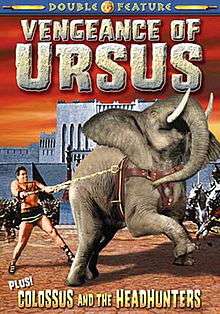The Vengeance of Ursus
| The Vengeance of Ursus | |
|---|---|
 | |
| Directed by | Luigi Capuano |
| Produced by | Splendor Film |
| Written by |
Luigi Capuano Marcello Ciorciolini Roberto Gianviti Nino Scolaro |
| Starring |
Samson Burke Livio Lorenzon Wandisa Guida Gianni Rizzo Nerio Bernardi |
| Music by | Carlo Innocenzi |
| Cinematography | Oberdan Trojani |
Release dates | April, 1961 |
Running time | 98 minutes (uncut) |
| Country | Italy |
| Language | Italian |
La vendetta di Ursus (The Revenge of Ursus), internationally released as The Vengeance of Ursus and The Mighty Warrior, is a 1961 Italian peplum film directed by Luigi Capuano.[1] It starred Canadian-born actor Samson Burke as Ursus, and Livio Lorenzon as the evil King Zagro. (Samson Burke later played Hercules in the American comedy film The Three Stooges Meet Hercules.)
Cast
- Samson Burke: Ursus
- Wandisa Guida: Sira
- Livio Lorenzon: King Zagro
- Nadine Sanders: Sabra
- Gianni Rizzo: Licurgo
- Nerio Bernardi: King Alteo
- Gina Rovere: Lidia
- Attilio Dottesio: Afro, Zagro's Servant
- Franco Fantasia: Captain of the guard
- Roberto Chevalier: Dario
- Ugo Sasso: Anio the bartender
- Ignazio Balsamo: Andros
Plot
The evil King Zagro (Livio Lorenzon) asks the king of a neighboring country (King Alteo) for permission to wed his daughter, the beautiful Princess Sira (Wandisa Guida), a political union that will join their two countries together. The mighty warrior Ursus, who fought for years in the army of King Alteo, has retired from the military to run a farm in the countryside with his little brother Dario. Ursus had once asked Alteo for the hand of the princess himself, but the king turned him down because Ursus was not of noble birth.
After Princess Sira travels to Zagro's kingdom to be wed, she learns that Zagro plans to assassinate her father after the wedding and then dispose of her at a later time, leaving Zagro in complete control of both countries. Zagro has a spy in Alteo's kingdom, the king's foppish advisor Licurgo, whom he uses to influence Alteo's decisions.
Ursus learns of the plot and wants to warn Alteo of the danger he is in, but Zagro captures Ursus' brother and threatens to kill the boy if Ursus does not surrender. Ursus turns himself in, and is forced to become a slave in Zagro's prison camp. When some rebels in Zagro's court free the boy from his captivity, Ursus is able to escape from the slave camp without fear of endangering his brother's life, and the two head back to King Alteo's kingdom, to warn him that he is about to be assassinated.
Licurgo uses his influence to make Alteo doubt Ursus' warning however, telling him that Ursus is lying about Zagro because he wants to marry the princess himself. Soon after, Licurgo arranges for an assassin to murder the king, and is able to frame Ursus for the assassination.
To prove his innocence, Ursus undergoes several tests of strength in an arena, the greatest of which involves being tied to an elephant which then drags Ursus closer and closer to a wooden wall bristling with razor-sharp knives. Ursus uses his great strength to resist the mammoth creature, and succeeds in convincing the people that Zagro was behind the assassination of their king. Enraged, Zagro stabs his confederate Licurgo to death.
In desperation, Zagro orders his armies to attack, and a tremendous battle ensues. During the chaos, Ursus stabs Zagro to death with his own sword, and liberates the people, as well as Princess Sira. Sira takes over the throne, and asks Ursus to rule at her side, and the populace celebrates their newfound freedom.
Overview
The plot of this film did not connect at all with that of the first Ursus film, Mighty Ursus (1960). In that film, Ursus returned home from the wars to marry his fiancee, but winds up riding off at the end of the picture with a young blind woman he falls in love with, presumably to be married. This 2nd entry in the series has Ursus running a small farm and taking care of his little brother (who's not even mentioned in the first film), and winding up in the finale agreeing to rule beside his beloved Princess Sira over their people. Thus it seems the Ursus films were not being made to connect with each other in any way, plotwise.
Vengeance of Ursus sported two of the Italian cinema's greatest screen villains of the 1960s, the sneering, bald pated Livio Lorenzon as King Zagro, and the thoroughly deceptive Gianni Rizzo as the foppish Licurgo, so as pepla go, this film is very strong in the villains department. Zagro is a real hands-on warrior, actually grabbing a sword and running madly into the street battle at the end of the film (a bad decision in hindsight). Wandisa Guida makes a beautiful and regal princess, and Samson Burke's massive physique allows him to really look the part of Ursus, his bulging biceps shown off especially well in the climactic "elephant tug-of-war" sequence. (Burke grew a beard a year later and played Hercules in the American-made comedy, The Three Stooges Meet Hercules, which satirized the then-popular peplum genre.)
Reception
Film critic Howard Hughes judged the film scored with a lot of action.[2]
Biography
- Hughes, Howard (2011). Cinema Italiano - The Complete Guide From Classics To Cult. London - New York: I.B.Tauris. ISBN 978-1-84885-608-0.
- Roberto Poppi, Mario Pecorari (2007). Dizionario del cinema italiano. I film. Rome: Gremese Editore. ISBN 8884405033.